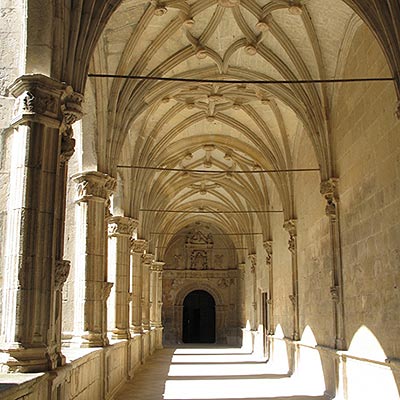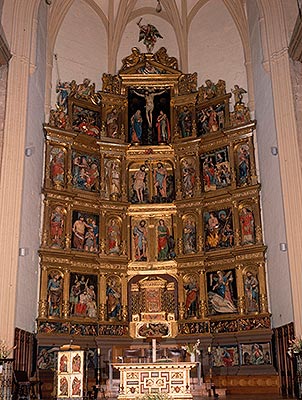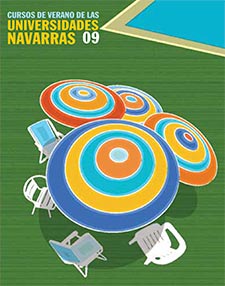BRINGING THE HERITAGE CLOSER. ESTELLA, ART AND THE ROAD
25 August 2009
The splendor of Estella in the Renaissance. Art and Artists
Ms. María Concepción García Gainza. Chair of Navarrese Heritage and Art.
Estella is, as is well known, a medieval city because of its urban layout on both sides of the Ega River and also because of its monuments, churches and monasteries. It was a market town, born and enlivened by the Camino de Santiago with its flow of pilgrims throughout the Middle Ages average. The 16th century will open on this medieval city with an important political event, the incorporation of Navarre to Castile in 1512 and with it that of Estella, after the surrender of the city and its castle. The political change will bring about a cultural, monumental and artistic renovation supported by an economic reactivation. The artistic novelties of the Renaissance were imported to the city by French masters whose work has come down to us in numerous works.
In the Renaissance, Estella will enjoy a high cultural level and will become an artistic center of certain importance. In the city, some families such as the Eguía, San Cristóbal or Eulate families undertook artistic enterprises in which the new Italian forms were manifested. Of special interest are the initiatives of different members of the Eguía family, such as Nicolás Martínez de Eguía, knight and president of the Brotherhood of Estella, who appears as a donor in the painted panel of the Mass of San Gregorio, accompanied by his wife Catalina de Jaso and twenty-six of his twenty-eight children in a painting that combines its funerary significance with the sociological interest of the collective portrait. Another member of the family, Juan de Eguía, was a true patron of the arts and in 1524 he promoted and paid for the General Hospital of Santa María de Gracia in Estella, similar to the archdeacon Remiro de Goñi who founded the Hospital de la Misericordia in Pamplona. Juan de Eguía also built the manor house of the Eguía family, with a courtyard and coat of arms on the façade inscribed in a Renaissance laurea. He also ordered the construction of his tomb in the parish of San Miguel and two altarpieces, one of them for the convent of La Merced in Estella, at position de maese Terin, true introducer of the "al romano" language. The manor house of the San Cristobal family, built around 1561, marks a clear advance in the use of Renaissance form and in the presence of mythology. Its relationship with the great work being done at this time in the cloister of Irache is evident, where the grotesque and busts of mythological figures prevail.

Crossing of the cloister of the Irache Monastery
On the other hand, the programs of study of Grammar, Humanities and Latin were promoted by the Study of Irache (1544) and by the Study of Grammar of Estella, belonging to the Regiment, which was in charge of the second teaching, from where the students passed to the University of Alcalá.
Estella was a cultural city, but also an artistic center in the Renaissance, continuing its medieval tradition, which had several family workshops of masters who cultivated the different arts and attended to the artistic commissions of the whole district. It was an important silversmith center, with its own trademark STELLA, the name of the town in Latin surmounted by a star, and important silversmiths such as Alonso de Montenegro, Andrés and Pedro de Soria, of whom a splendid collection of processional crosses is preserved. Also from Estella were the famous ceramists and tile makers linked later to Aragonese ceramics, but above all sculpture was the most splendid art of Renaissance Estella.
In contrast, painting has left few brush-painted works, but many altarpieces and tabernacles with exquisite polychromies executed by true dynasties of painters from Estella, whose names are well known thanks to Pedro Echeverría and his Policromía del Renacimiento en Navarra, and whose works are among the best in Navarre. Juan de Bustamente was from Estella, although his paintings are outside Estella (Huarte and Cizur), but it was Miguel de la Torre (first third) -who inaugurated the Roman polychromy and polychromed the works of Maese Terin, continued by his son Pedro de la Torre-, the best polychromator of the time in Navarre and master of the Miñano family. In the second half of the century, Miguel and Lucas de Salazar stood out together with other painters representing the counter-reformationist painting. Francisco Martínez de Nájera polychromed the altarpieces of the Imberto family.

Main altarpiece of the parish church of San Juan de Estella
There is a main event that takes place now from the point of view of sculpture. It is the construction of the main altarpiece of the parish of San Juan de Estella, which can be considered summary of all the trends of the time and the starting point for the sculpture of the city in the second half of the century. The altarpiece of San Juan and its complicated history, so well known, meant in Estella, from the artistic point of view, the full introduction of Italian Renaissance forms and compositions, mainly from the circle of Raphael, as Raimondi, whose engraving of the Fifth Anguish copies. It was also the first echo in the religious art of Navarre of the conciliar mandates and of the incipient diffusion of another tendency.
This new tendency that we know as 'Romanism' will be cultivated and spread by the three great family sculpture workshops: the Gabiria, the Troas and the Imberto, which we see concurring in the altarpiece of San Juan de Estella and whose activity will develop in the second half of the 16th century until entering the 17th century, a period in which the rise of the sculpted altarpiece is evident and which forms a particularly rich chapter of Navarre's art.
The cultural splendor that the city of Estella reached in the 16th century with the printing press, the study of grammar and the cultivation of the classical programs of study in the monasteries and the dynamic activity of the family workshops of silversmiths, painters and sculptors, together with some artistic enterprises promoted by patrons and promoters, continues in a certain way the brilliance of its medieval past that will lead to a splendid Renaissance.
PROGRAM
TUESDAY, AUGUST 25
The splendor of Estella in the Renaissance. Art and Artists
Ms. María Concepción García Gainza. Chair of Navarrese Heritage and Art.
Image of God, image of man: the façade of San Miguel de Estella
Mr. Javier Martínez de Aguirre Aldaz. Complutense University of Madrid
San Pedro de la Rúa: styles and interstyles in a medieval building.
D. Carlos J. Martínez Álava. I.E.S. "Pedro de Ursua" of Pamplona
WEDNESDAY, AUGUST 26TH
Following in the footsteps of the Gothic in Estella: Santo Sepulcro and Santo Domingo
Ms. Santiaga Hidalgo Sánchez. Chair of Navarrese Heritage and Art.
Estella's movable heritage
Ms. Mercedes Jover Hernando. Chair of Navarrese Heritage and Art.
A city born for the Camino. visit guided tour of the city of Estella
D. Román Felones Morrás. Full Professor of Geography and History of the I.E.S. Tierra Estella.
THURSDAY, AUGUST 27TH
Architecture and Humanism in Estella in the 16th century.
Mrs. María Josefa Tarifa Castilla. Chair of Navarrese Heritage and Art.
Traces of the Baroque in Estella
Ms. Pilar Andueza Unanua. Chair of Navarrese Art and Heritage.
The sumptuary arts in Estella: from the Age average to the 19th century.
D. Ignacio Miguéliz Valcarlos. Chair of Navarrese Heritage and Art.
FRIDAY, AUGUST 28TH
Images of a conflict. Estella and the last Carlist War
D. Ignacio Jesús Urricelqui Pacho. Chair of Navarrese Heritage and Art.
reportIdentity and image of Estella in the plastic arts of the 19th and 20th centuries.
Mr. José Javier Azanza López. Chair of Navarrese Heritage and Art.
Museum and city. Gustavo de Maeztu and Estella
D. Gregorio Díaz Ereño. Director of the Jorge Oteiza Museum.
Closing

